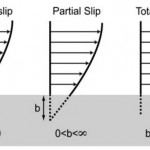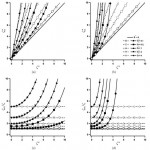Electrophoresis, 2008: Zeta potential and electroosmotic mobility in microfluidic devices fabricated from hydrophobic polymers: 2. Slip and interfacial water structure
Citation: Tandon V, Kirby BJ. Zeta potential and electroosmotic mobility in microfluidic devices fabricated from hydrophobic polymers: 2. Slip and interfacial water structure, Electrophoresis, 29(5): pages 1102-1114. doi pdf
Abstract: We discuss the structure of water at hydrophobic interfaces from the standpoint of its impact on electrokinetic phenomena in microfluidic devices fabricated from hydrophobic polymers such as Teflon(R) or Zeonor(R). Water structuring at hydrophobic interfaces has been described as a source of interfacial charge (see Part 1, this issue), and dewetting phenomena, whether via depletion layers or nanobubbles, contribute to slip and enhanced apparent electrokinetic potentials. Issues concerning the impact of hydrodynamic slip and the role of diffuse interfacial structures are discussed. These issues are coupled with each other and with interfacial charge concerns, providing challenges for measurements of individual parameters.
Figures:
- Figure 1. Scheme showing an interpretation of the slip length, b.
- Figure 2. Plots of (a) z*_a vs. z* for a 1:1 electrolyte, (b) z*_a vs. z* for a 3:3 electrolyte, (c) z_a/z vs. z* for a 1:1 electrolyte, and (d) z_a/z vs. z* for a 3:3 electrolyte. Closed symbols and solid lines correspond to the nonlinear solution to the Poisson-Boltzmann Equation (Eq. 13). Open symbols and dashed lines correspond to the Debye-Huckel approximation (Eq. 9). z*_a = z_a/kT/e and z* = z/kT/e. For reference, kT/e at room temperature (293K) is 25 mV.
- Figure 3. Numerical solutions to Eq. 1 for a 2:1 ratio of monovalent anions to divalent cations over a flat plate. (a) z*_a vs. z* for a positively charged plate, (b) z*_a vs. z* for a negatively charged plate, (c) z_a/z vs. z* for a positively charged plate, and (d) z_a/z vs. z* for a negatively charged plate. z*_a = z_a/kT/e and z* = z/kT/e. For reference, kT/e at room temperature (293K) is 25 mV
- Figure 4. Schematics of (a) a depletion layer, (b) roughly hemispherical nanobubbles, and (c) structuring of water on hydrophobic microfluidic substrates. In (c), the dipole moment direction on a representative water molecule is indicated by an arrow.





